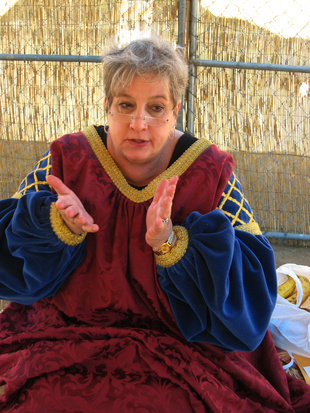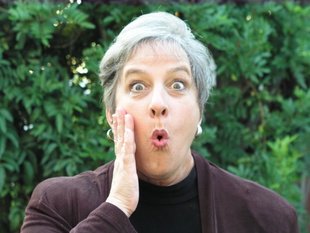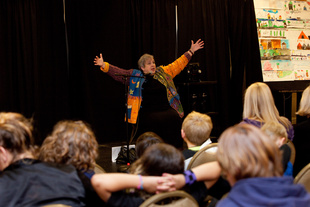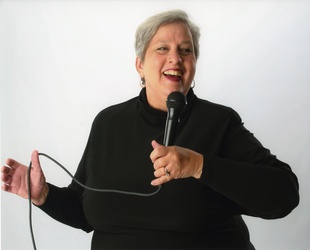Marilyn McPhie

Tell us how you became a storyteller.
I come from a family of word-lovers, so I came into storytelling naturally. My mother’s mother majored in elocution and I often heard her recite poems and other pieces. My father’s mother wrote poetry and many times was called upon to present her poems for special occasions. My mother taught English and drama. I was always surrounded by books and stories. In high school I was on the speech team and in college I majored in English, but I didn’t really discover storytelling until I was an adult.
When my two oldest children were three and four, I signed them up for a parent participation preschool, and the school was very serious about the participation element. They handed me a three-page list of possible jobs. One job was cleaning the bathrooms every week. I didn’t want to do that. Another job was sanding and repainting the playground equipment. I didn’t want to do that. One of the jobs on the last page was, “Tell stories every week,” and I thought, “I could do that.” So I signed up to tell stories, and it was so easy and fun that I signed up for storytelling every semester after that. Then I began telling stories at the local library. After that people began to ask me to tell stories for schools and festivals and I began to feel like a real storyteller.
Where do your stories come from? How many do you create? How many are retellings?
I’m omnivorous about stories. I’m eager to pick up stories wherever I find them, so the stories I tell come from many different sources.
I love folktales; there’s something about telling a traditional story that makes me feel that I’m a part of something ancient and important. All of the folktales I tell are my own retellings. Usually, I take several different versions of a story and shape them in the way that feels comfortable to me. I don’t usually memorize, because learning a single version of a story word for word would require a lot of time and the end result would not be as suitable for telling. For one thing, written language is often quite different from spoken language; spoken language tends to have more short, declarative sentences, sentence fragments, and repetition. For another thing, there could be copyright issues if a storyteller just memorizes someone else’s version of a story. Most importantly, retelling with my own words and in my own voice gives me the freedom to emphasize the things I like—to give the story my own twist.
I do tell some literary stories written by authors like Jane Yolen and Brock Cole. For these, I try to stick to the author’s words. And I do get permission to tell them.
With the recent popularity of “This American Life,” “StoryCorps,” and “The Moth,” personal stories have become more and more popular in performance. Of course, like most people, I have always used personal experiences in talks, lessons, and conversation, but lately I have started shaping some of them into stories that I tell on the stage. I’ve even participated in a couple of story slams.
And I do have a few stories that I have created entirely. I would say “written,” but actually I develop the story orally before I ever write it down. This works well for me, since the story is meant to be told. Of course, I do write down the story eventually—mostly to help me remember it when I go back to it after a while. When I make up my own stories, it is usually because I looked for a story with a specific theme or setting and I could never find it. So I tell a story about a witch, inspired by my ancestors in Salem, Massachusetts. Another story, set in Aztec times, is about chocolate. And there’s a story about a fish that I created for a performance at an aquarium.

Does telling stories ever spill over into other aspects of your life?
My casual conversations with both friends and strangers are often story-rich, but then I think most people tell stories. It’s only a problem if the stories are too long, too detailed, or you just tell the same half-dozen stories over and over and over. (We all know people who do that!) My family and friends are usually pretty nice about my storytelling. They expect me to tell stories and they indulge me. A couple of times my brother and sister have heard me tell family stories and they have said, “I don’t remember that,” or “I don’t remember that it happened that way.” Since I’m the oldest, I can always reply, “Of course not. You were too little to remember.”
Every summer I judge a stack of storytelling CDs for a national awards program, so whenever I’m going somewhere in the car, I usually have one of the entries in the CD player. Most, but by no means all, of them are really good. However, a few years ago, my son always made sure that when we were in the car, he had what he called his “story-cancelling headphones.”
Everyone loves a good story. Why do you think stories are such an integral part of the human condition?
Storytelling is one of the things that makes us human. Many animals vocalize, but people tell stories. They link us to the past and connect us with each other in the present. They lift the spirit, acknowledge feelings, illuminate thinking, challenge, and inspire. They represent a culture’s very identity.
It seems that storytelling is an integral part of Mormon worship. Primary sharing time, Sunday School lessons, and General Conference talks are just a few of the places where stories seem to abound. Why do you think that is?
Because there’s no better way to get an idea across than with a story. Stories stick. I’ve worked in Relief Society, Primary, Young Women, Sunday School, nursery—and in every case, I find that the best, most effective lessons have stories. When I was doing Primary sharing time regularly for several years, at first I tried to have what I considered the more typical presentations—with flannel board cut-outs and games, but I quickly realized that, for me at least, the most successful sharing times featured stories—told, not read. (Of course, the stories were from approved materials, like The Friend or scriptures. I’ve read the handbooks.) The same thing is true in adult classes and sacrament meetings. We like stories. At General Conference, the most touching, inspiring and memorable talks seem to be those with stories. President Monson and many of the other general authorities are great models for this. And of course, the scriptures show the power of the Savior’s stories. “A certain man had two sons…” When you read the scriptures, a line like that is the equivalent of “Once upon a time.”

From sightings of the Three Nephites to tales of the Mormon pioneers and other faith-promoting stories, it seems that storytelling extends to nearly all aspects of Mormon culture as well. Why do you think this phenomenon occurs?
As a people, we believe that our Heavenly Father hears our prayers, knows our hearts, and wants us to be happy. And so we are eager to believe and to pass on stories that illustrate that care and concern. As with most oral storytelling, the stories pass from one person to another, with each teller shaping and embellishing in a way that will enhance the telling and emphasize the point of the story. So the stories get bigger and grander and more miraculous as they pass from one storyteller to another. I love this aspect of Mormon storytelling; it’s the oral tradition at work. Of course, sometimes the stories need to be reined in a little and anchored to facts. We can do that when necessary. I have noticed, for example, that lately the conference talks have footnotes and references, so that listeners and readers can refer to sources for themselves, and more and more primary-source materials are readily available for anyone to use.
How do you think an audience responds differently to a story being told to them rather than reading it for themselves?
Reading a story is a rather solitary activity. Listening to a story told is a shared experience. It’s communication eye-to-eye and face-to-face and heart-to-heart. And the communication happens in real time. When an author writes and publishes a story, the author sends it out into the world to be read at some future time by an unseen and unknown audience. Reactions may come from readers and critics, but they are far removed in time from the creation of the story.
With live storytelling, the listeners are present and their response is instantaneous, and, in fact, can change the story even as it is being told. Another big difference between reading a story and hearing a story is that a storytelling is ephemeral. It happens, and then it’s over.
Even if the same storyteller tells the same story to the same audience again, the story and the experience will be different; it’s very fluid. If you read the same story over, the experience may differ somewhat, but the words and presentation are fixed and do not change.
So much of storytelling is in the visual experience of the audience in addition to the words of the teller. Besides recording performances, how are these stories preserved?
The best storytelling performance is the one you see and hear for yourself. That’s the nature of storytelling. But it is still valuable to preserve stories in a more permanent form. It may not be as vivid as a live performance, but it can still be a good experience, and the potential audience is much, much larger than would fit under a festival tent or in a theater. Video recording, audio recording, and written transcripts are all useful ways to preserve oral stories.
A well-known storyteller who has preserved his stories in published books says that he wants to share the stories with people who would never have the opportunity to hear him in person. That’s why he writes them down. His written stories do differ a bit from his oral telling. They are longer, wordier. He has learned that he needs to put in writing the things that at a performance would be conveyed by his tone of voice, a gesture, a posture.
What are the pros and cons of the fluidity of a verbal story? Do you think it is a good or bad thing that spoken stories change and evolve with each telling?
I know that in some cultures, storytellers are expected to memorize the important stories and tell them the same way each time. In this way, the traditional stories are heard in the same manner, or at least with the same words, as they were centuries ago. I see the reason for that. However, for my storytelling, I value the opportunity to adapt the stories to the audience, the occasion, even the time constraints. I have been known to take a long, traditional folktale that I usually tell to adult audiences and shorten it to five minutes, lighten the tone, simplify the language, and add a little audience-participation song. That allows me to share a good story with an audience of young children.
Conversely, a kid’s story can be adapted for adults. Make the language more sophisticated; give it a new slant; emphasize the complex thematic subtleties that adults appreciate. I like the freedom and creativity in that. If a train goes by or a news story has just broken or it’s someone’s birthday or the lights suddenly go out or there’s some other current or unexpected element, it’s great to be able to respond to it and not just plow ahead with the memorized text.
Do you have any particularly memorable experiences when you were telling a story?
Once I was hired to tell stories to teenagers who had been expelled from regular schools. Most of them had been in trouble with the law. Many had issues of abuse and addiction. As they filed into the room, I could see that they were probably thinking, “A storyteller? Seriously? What could this gray-haired grandma have to say to me?” I told them, directly and unapologetically, the strongest stories I knew. Stories, some centuries old, of promises, struggles, self-image, family, relationships. I saw a change in their faces. They knew that these were not the stories I would tell to five-year-olds. They sat up and paid attention. When I was finished, I heard several exhale, almost as though they had been holding their breath the entire time. It was a good moment.

How has the gospel shaped your storytelling?
Often when I tell stories, people ask later, “Is that a true story?” Even when the story has talking animals or flying carpets, the question still comes. My answer is that I never tell stories that I don’t believe—either factually, or metaphorically, or both. I tell stories that I believe—and my beliefs are shaped by the gospel. I like telling stories that reinforce gospel principles of love, forgiveness, peace, kindness, inclusiveness, faith, and giving. Even when I tell stories with tricks and traps, they inevitably serve the cause of justice and fairness. I try to keep my storytelling in the realm of things that are “beautiful, lovely and of good report and praiseworthy.”
You belong to several storytelling organizations. How does collaborating with other storytellers improve your work?
As with almost any work—or, in fact, any human endeavor—collaboration and cooperation are very helpful. When I listen to other storytellers perform, I enjoy seeing what stories they choose, how they shape them, how they deliver them. It’s inspiring and motivating. When storytellers gather for meetings and workshops, we can explore ideas, techniques, and resources. We can also share information and experiences in promotion, marketing, producing, and other “nuts-and-bolts” aspects of the storytelling business that storytellers, like other people in the arts, often avoid.
Working with others can be exhilarating. It could be simply putting together a program with several storytellers in a way that the stories work well together. Sometimes it’s more complex than that. Last year I got a grant to work with an excellent classical pianist on a storytelling project. That was something completely different for me. I offered a selection of stories that I thought might work well with music. The pianist chose some pieces from her repertoire that she thought could partner with the stories. We picked out several possibilities and cut and adapted and rehearsed until we had a blend that satisfied both of us. It was hard work and a very different way of looking at storytelling for both of us. We loved it. This summer I’m going to start working on a collaboration with a dance company for a program of stories that promote peace. I’m looking forward to that as another stretching exercise.
You’ve mentioned that the Timpanogos Storytelling Festival (held in Utah) is one of the best-attended and most-recognizable storytelling events in the country. Why do you think that’s the case and in your experience what reputation do Mormons and their stories have in the broader storytelling world?
The Timpanogos Storytelling Festival was started and is organized by good, dedicated, creative, smart, savvy people who love bringing great stories and great storytellers to Utah. In difficult economic times, when arts funding has been cut everywhere and when many storytelling festivals are having trouble selling tickets and raising enough money to put on a festival, I think Timpanogos is astonishing the national storytelling world. They have huge, very enthusiastic audiences. They have many, many generous private and corporate donors. They have hundreds of dedicated, hard-working, committed volunteers. Of course, not all of them are Mormons. The committees are quite eclectic and representative of the entire community. However, I do think that a big storytelling festival is a perfect fit for a Mormon community. Mormons have had a huge commitment to theatre and the arts since pioneer times. Ward buildings have stages and “cultural halls.” Plays, productions, and even enormous pageants are familiar to us. We love a good show. In addition, Mormons are very committed to community service. We volunteer. We have wide experience in planning and carrying out big programs, and we are comfortable working within a very organized structure. We plan, we act, we report, we collaborate. Practically speaking, church experience is a great school for community work. The people at the Timpanogos Festival have both the hearts and the hands to make it successful.
In the larger storytelling world, Utah, Mormons, and Timpanogos are becoming more and more well known and highly regarded. At first no one could pronounce or spell Timpanogos. Utah? Really? But now, the best-known storytellers have performed at Timp, have been impressed by the organization, and have been delighted by the responsive audiences. Every storyteller I know is eager to be featured at the festival. Several years ago, some storytellers didn’t know what to expect. Would all their stories need to be sugarcoated? Just how clean did the language need to be? Could they even get a cup of coffee in Utah? Are Mormons as weird as they’d heard? That uneasy feeling has disappeared as more and more storytellers see what great audiences Utah has—not just at Timpanogos, but in the entire area. Many other festivals have been inspired by and have learned from the Timpanogos Festival.
How do you see your work building the kingdom?
I think that much good can come from stories. They appeal to everyone on the most elemental level. They can build character, invite introspection, promote empathy, preserve culture, encourage community, and illustrate gospel principles—all things that build the kingdom. I love what I do. I think it’s good and important work.
Any last thoughts or advice?
Often when we see professionals at work—from sword-swallowers to electricians—there is the warning: “Don’t try this at home.” There are some things that should be left to people with extensive training and certification. That is not the case with storytelling. Do try this at home. The world would be better if everyone shared stories. ❧
